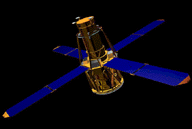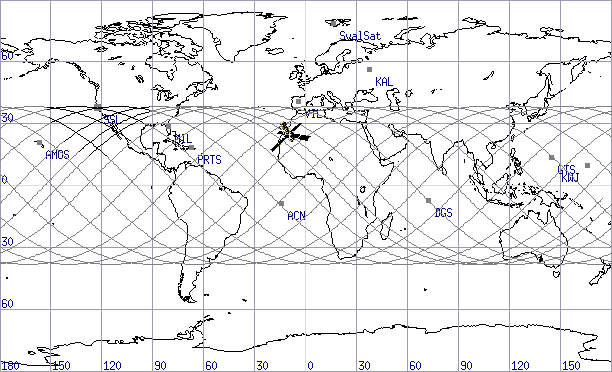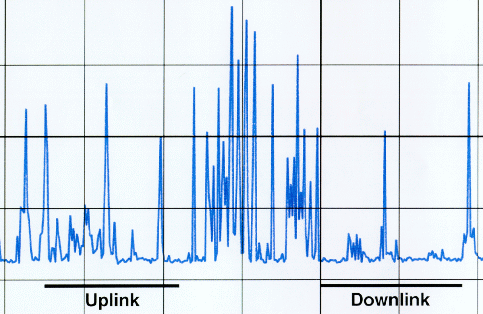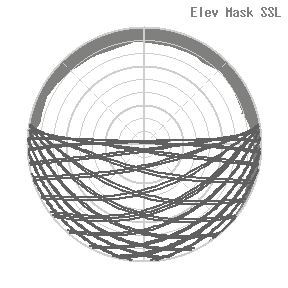|
|
|
|

The High Energy Solar Spectroscopic Imager (HESSI) will investigate the physics of particle acceleration and energy release in solar flares. Observations will be made of X-rays and gamma rays from 3 keV to 20 MeV with an unprecedented combination of high resolution imaging and spectroscopy. HESSI uses Fourier-transform imaging with 9 bi-grid modulation collimators and cooled germanium detectors mounted on a Sun-pointed spin-stabilized spacecraft. It will provide the first imaging spectroscopy in hard X-rays with about 2 arcsec angular resolution, time resolution to tens of milli-seconds, and about 1 keV energy resolution. HESSI will also provide the first gamma-ray line spectroscopy with 2-5 keV energy resolution and the first gamma-ray line and continuum imaging with 36-arcsec angular resolution. HESSI is scheduled to be launched in July 2000, in time to detect the thousands of flares expected during the next solar maximum. The spacecraft will be launched into a 600 km circular orbit at an inclination of 38 deg from Kennedy Space Center, Florida. The launch vehicle will be an Orbital Sciences Corporation Pegasus XL. The expected mission life time is 2-3 years. The total mission budget is 72 million US dollars. |
| HESSI will make 6 passes per day of 9.2 minutes average duration over the primary ground station located at Berkeley, assuming an elevation mask of 5 deg. The world map below shows the ground track for 16 orbits. Access to the Berkeley Ground Station is indicated by the darker sections of the ground track. |
 |
| Black-out periods due to
a solar elongation of the spacecraft of less than 10 deg, as seen from
the ground station, amount to less than 1% of the total contact time. Therefore,
a net downlink data rate of 4.0 Mbits/s will allow an average data volume
of 11 Gbits/day to be downlinked. Telemetry data are transmitted using
BPSK modulation and CCSDS-recommended Reed-Solomon coding.
Based on the heritage of other SMEX missions, communications for telemetry and command operate at S-band. The spacecraft communications subsystem consists of a transceiver with 5 Watt output power, RF assembly and four antennas with hemispherical coverage (two for transmit and two for receive) to ensure full-duplex capability, regardless of spacecraft attitude. Power, weight and cost budgets, as well as component reliability issues for the spacecraft subsystems require a sensitivity of 20 dB/K or larger of the ground station to maintain a positive link margin at 5 deg elevation. The predicted link margin for downlink with an 11-m antenna is approximately 3 dB. |
| Concern has been expressed regarding the utilization of S-band frequencies for the HESSI mission with a ground station located in the San Francisco Bay Area. According to the National Telecommunications and Information Administration (NTIA), the 2025-2110 MHz band that is proposed to be used for the HESSI command uplink is also allocated for usage by fixed and mobile terrestrial services, for instance by television broadcasters for one-way transmission services such as links from vans or helicopters to the studios. Since virtually all of the low-power, low-bandwidth and short-duration transmissions from the Berkeley ground station to the HESSI spacecraft are directed toward the sky, the interference to terrestrial services is expected to be rather minimal. The 2200-2290 MHz band segment proposed to be used for telemetry downlink is predominantly used for Federal terrestrial and space telemetry systems. Space applications include the NASA Tracking and Data Relay Satellite System (TDRSS) and the Air Force Space Ground Link Subsystem (SGLS). Terrestrial telemetry in this band is mainly used for various experimental and operational air-to-ground links. |

A preliminary S-band spectral survey was conducted in order to determine the usage of frequencies in the proposed range. A probe antenna was placed on the roof of the Silver Lab. A number of S-band spectra in the frequency range from 1950 to 2450 MHz were recorded with a spectrum analyzer in maximum hold mode. The 2200-2290 MHz band that is proposed for telemetry downlink appears to not be occupied by any fixed services in the vicinity of the HESSI ground station. Only occasional signals that lasted for a number of minutes were recorded. Most of these were weak and are presumably other satellite downlinks. Signals observed in the 2025-2110 MHz uplink band only lasted for short periods of time. A high-gain antenna will be instrumental to provide a solid link margin and thereby make the telemetry downlink channel less susceptible to potential interference. The narrow beam width of a large antenna and also low sidelobe levels will reduce the risk of occasional interference with downlink transmissions from other spacecraft that might pass through the antenna beam. The HESSI orbit is rather unique in the sense that it is not occupied by many spacecraft, which further reduces the risk of interference. A request for allocation of S-band downlink and uplink frequencies for HESSI has been submitted to the frequency manager at NASA/GSFC. |
| The Berkeley
Ground Station, built by EMP Systems,
consists of an antenna pedestal with an 11-m solid-surface
parabolic dish, an antenna controller, RF, IF and baseband systems, and
subsystems for CCSDS data processing, telecommand generation, data storage,
data transmission, time tagging of transmitted and received packets, remote
control and environmental monitoring.
Operation at S-Band allows full-duplex communications with the spacecraft. The figure of merit, G/T, of the receiving system is expected to be 23 dB/K at elevations above 10 deg. Below this elevation, atmospheric losses and thermal radiation from the Earth received through the sidelobes will degrade the ideal perfomance. The antenna pedestal is a three-axis mount that allows continuous tracking of the spacecraft during overhead passes at a rate of 10 deg/s in azimuth and elevation angles. Maximum operational wind speed is 40 mph and survival wind speed in the stow position is 120 mph. The antenna is required to point with an accuracy of 0.05 deg and has built-in features for autotracking and program tracking. The feed system allows RHCP and LHCP for both transmit and receive. The receiving equipment includes two receivers for RHCP and LHCP, and a diversity combiner. A dedicated workstation will perform the bit synchronization and CCSDS data processing, temporary local data storage and data forwarding to the Mission and Science Operations Center (MSOC) computers. For command uplink, the ground station antenna is equipped with a 100-W transmitter. The modulation is BPSK/PM with a 16-kHz subcarrier and a data rate of 2 kbits/s. The PM modulation index will be 1.0 rad. The predicted link margin for the command link is about 20 dB for a bit error rate of 10-7 at 5 deg elevation. Part of the ground station equipment will be installed at the antenna, whereas other subsystems will be located inside the MSOC at Space Sciences Laboratory. Microwave fiber-optic links will be used to bridge the distance of 1200 ft to connect the RF and IF subsystems. Test equipment includes a spectrum analyzer, frequency counter, power meter, bit error rate tester and an oscilloscope. |
The site that was selected
for the installation of the antenna is located within 1200 ft of the MSOC.
The key requirement for the site is to provide a clear view of the sky
down to an elevation of 5 deg. The polar  plot
to the left shows all passes of the HESSI spacecraft over a period of 6
days. Elevation circles are spaced by 10 deg. The outermost circle is the
horizon line and the center corresponds to the zenith. The station mask
comprises nearby structures between west and north-east and nearby hills
between north-east and south-east. For most passes, the spacecraft can
be acquired at an elevation of 5 deg, and at 7.5 deg otherwise. plot
to the left shows all passes of the HESSI spacecraft over a period of 6
days. Elevation circles are spaced by 10 deg. The outermost circle is the
horizon line and the center corresponds to the zenith. The station mask
comprises nearby structures between west and north-east and nearby hills
between north-east and south-east. For most passes, the spacecraft can
be acquired at an elevation of 5 deg, and at 7.5 deg otherwise.
The site preparation is carried out by
the UCB Planning, Design and Construction Department. This task comprises
leveling of site, eucalyptus tree removal, casting of a concrete foundation,
paving the surface around the antenna, installation of a security fence,
and a surveillance camera plus lighting. Electrical power and communications
lines will be routed from the Space Sciences Laboratory. Site work is planned
to be completed by the end of June 1999.
The SatTrack Software Suite has been selected for generation of all mission-critical ephemeris products, like scheduling of passes over the primary ground station and possible back-up stations, timelines of shadow periods, passes through the South-Atlantic Anomaly, attitude and communication timelines, real-time monitoring of the spacecraft location with graphical displays, and creation of track files to control the antenna. The SatTrack Gateway Daemon will be the central scheduling tool used to support fully autonomous operation of the HESSI ground station. The SatTrack Software Suite is provided and maintained by BTS. During the last two years experience has been gained in maintaining a local data base of orbital element sets. A fully automated procedure is already in place that downloads element sets in NORAD two-line format daily from the Orbital Information Group server at GSFC, using the HTTP protocol that is invoked from a UNIX timer function. The element sets are automatically archived and can be used for real-time tracking or for generation of ephemeris products needed to analyze data taken with the FAST spacecraft. During the HESSI mission, the most recent data set will be used to automatically create orbit event files, composite schedules of contact times for multiple ground stations and track files to control the antenna of the Berkeley Ground Station. |
| The pre-pass operations
will begin about 30 minutes before a scheduled pass. During this period,
health and safety checks of the ground station will be performed. The telemetry,
command and tracking functions will be tested. Finally, the antenna will
be slewed to the initial acquisition angles and the transmit power amplifier
will be powered up. As soon as the spacecraft rises above 2 deg elevation
or the local elevation mask, the transmitter on the spacecraft will be
turned on, either as a pre-programmed command or by real-time commanding
from the ground station. The antenna will automatically follow the predicted
satellite path, either in program tracking or autotracking mode.
A typical command and telemetry sequence can be envisioned as follows. The spacecraft turns on its transmitter at elevation of 2 deg to allow the ground station receivers to lock-up. As soon as the receivers are locked and the downlink carrier signal is stable, the ground station will send a signal to start telemetry transmission for one minute. Then, if the data were received with good quality, another signal is sent to start the next data set. Otherwise, a signal is sent to retransmit the same data set. If a null in the antenna pattern is predicted, the transmission will be halted briefly. Once the spacecraft reaches 5 deg elevation on the descending part of the pass and the reception of the last data set is completed, the antenna will slew to the stow position and the power amplifier will be powered down. Data will be transmitted from the ground station via local Ethernet to the MSOC computers in real-time, as they are received by the ground station. As a back-up,data are also temporarily stored at the ground station. The ground station is equipped to store up to four days of telemetry data (4 GBytes). |
| Launch from Kennedy Space Center will result in a trajectory that allows a contact opportunity on the first revolution, about 80 minutes after orbit insertion. Therefore, initial acquisition of the spacecraft is based on the knowledge of the insertion state vector. The spacecraft will be pre-programmed to turn on the transmitter 80 minutes after orbit insertion for the duration of the first pass. The ground station antenna will be employed in autotracking mode with a spiral or raster scan to acquire the spacecraft. The azimuth and elevation angles will be recorded. Subsequently, the SatTrack Orbit Determination Tool will be used to refine the state vector in order to predict look angles for following passes. This procedure will be repeated until NORAD element sets will become available regularly. In addition, support will be requested from NORAD to provide refined element sets based on input from tracking stations with C-band radar and optical sensors. |
| The Berkeley
Ground Station is designed to be a fully autonomous system, allowing
two-way S-band communications with the HESSI spacecraft. The ground station
is planned to be operational in the summer of 1999, one year before launch
of HESSI. This will allow end-to-end testing during the integration and
test phase, when HESSI will be located at a clean-room facility less than
1000 ft from the ground station. During this phase the HESSI team will
be able to establish that all communications systems perform according
to specifications. The period between start of operation of the Berkeley
Ground Station and launch of HESSI will also be long enough to allow for
tracking of other spacecraft, to practice the data acquisition procedures
and to optimize the performance of the ground station in terms of pointing,
sensitivity, data handling and overall functionality.
Even though the Berkeley Ground Station is designed to work autonomously, communications with the HESSI spacecraft will be very closely monitored during the integration and test phase and also during the post-launch and early orbit operations phase of HESSI. |
| The HESSI mission requires back-up ground stations that will be called up in case the Berkeley Ground Station becomes temporarily unavailable, for instance due to high-wind conditions or extended power outages. Back-up support will also be requested if special solar events create data volumes that are beyond the capabilities of a single ground station. A contract with NASA or a commercial company will be negotiated for support on short notice. Back-up support will be exercised once per week to maintain a high level of proficiency. |
| A Summary of Technical Specifications for the request for proposal for the Berkeley Ground Station can be found in a separate document. |